
Paid Family Leave supports communities
Secret Life of FMLA: Shifting the Family Leave Conversation from She to We
I was out the other night with some of my colleagues and we were discussing ideas about what could help create a more supportive work culture at our university. The only two women at the table spoke about the need for more family friendly workplaces, specifically the need for paid family leave. We spoke about patched together leave that we or other women we knew had managed for the births of children. I told them that I was only able to take three weeks for the birth of my second son because I couldn’t afford to take unpaid leave and I didn’t have enough sick days to cover longer. My female colleague confirmed that these stories were “typical” of many women faculty at our university.
Maybe speaking about the struggles women face when trying to plan for a supported birth should be surprising but, unfortunately, for me this conversation is commonplace. The birth of a new child is a financial risk for many women. In higher education, it can also be a professional risk; so conversations about negotiating parental leave often happen informally between women colleagues in hushed conversations behind closed doors. Therefore, what was so striking about this conversation was how very surprising it was to the men at the table. “Wait,” one colleague said, asking us to back up and start from the beginning.
“What exactly is FMLA?” he wondered.
We explained.
The Family Medical Leave Act of 1993, or FMLA for short, entitles eligible employees to take up to 12 work weeks of unpaid, job-protected leave in a 12 month period for specified family and medical reasons; one of which reasons is the birth or adoption of a child. FMLA allows for employees to substitute paid leave, sick days, or vacations days to cover some (or all) of the leave period but these terms are determined by the employer.
While significant and important, FMLA has shortcomings. Not all workers qualify for FMLA and many that do (like me!) can’t take the whole 12 weeks because it is unpaid. It is also much shorter than most family leave policies in other parts of the world.
This was news to our table. As a father to two young children, one colleague in particular was taken aback by this news. “FMLA covers fathers,” he asked, his face twisted with incredulity.
Our table speculated on the impact that leave could have had for his family with the birth of a second child, on what a difference that could have made in their lives, on how it could have helped his wife. They were, he explained, “still tired” from those early years.
No one at my university had ever told him about parental leave as something that applied to or involved him. The culture of work within higher education—like many places in this country—conceives of family leave as a “narrow” women’s issue. The reality is that family leave is a community issue. It’s about supporting families, about supporting the health of our communities. Family leave, as it is conceived in FMLA, also supports taking care of an injured military family member, of caring for aging relatives, of undertaking necessary health procedures, AND caregiving for new children.
Part of the shift that must occur for the U.S. to make workplaces more family friendly is that we must broaden our own narrow definitions of family. We must begin to rethink the notion of “family policies” as policies that only apply to women. We must untangle the gendered web of caregiving, to make room for the complexity of modern families.
But, maybe more importantly, we must also begin to value mothers if we are ever to see a real shift in the culture of work in our country. Even as gender roles change and studies show an increase in men’s role in raising children, “women still do 2.1 hours of childcare for every hour contributed by married men[1].” This means that we must expand our definitions of caregiving, even as we also work to change the way we value those that already act as caregivers. Until we recognize the caregiving work that women have historically and currently do for our families, our communities, and our nation we will continue to see issues like paid leave as marginal.
Heading into November elections, let’s shift the conversation to talk about policies that matter for families. Let’s work to hold government accountable for what they do—and do not do—to make workplaces more family friendly.
#WeVote #WeMatter and we want #PaidFamilyLeave.
[1] Eagly and Carli. Through the Labyrinth: the Truth about How Women Become Leaders. Harvard Business School Press, 2007.

The views and opinions expressed in this post are those of the author(s) and do not necessarily reflect those of MomsRising.org.
MomsRising.org strongly encourages our readers to post comments in response to blog posts. We value diversity of opinions and perspectives. Our goals for this space are to be educational, thought-provoking, and respectful. So we actively moderate comments and we reserve the right to edit or remove comments that undermine these goals. Thanks!